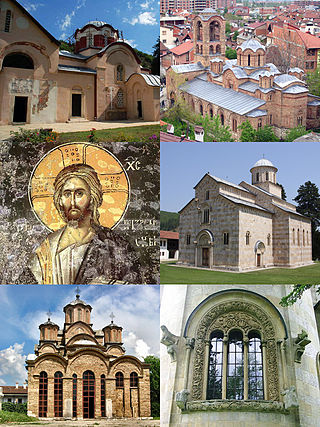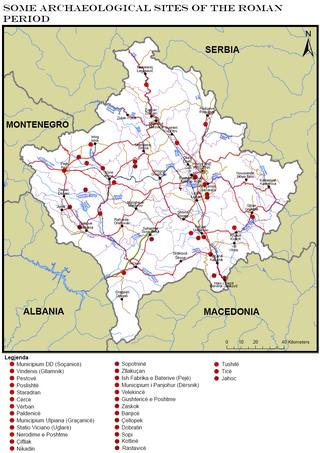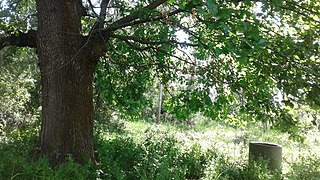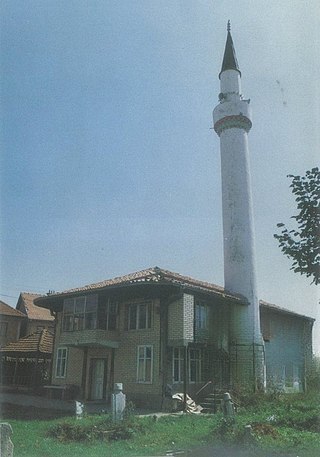
The Architectural complex in Maletaj is a cultural heritage monument located in Maletaj (Gumnisht), Vushtrri, Kosovo. [1] This monument is of the "Architectural" category, approved with number. [2]

The Architectural complex in Maletaj is a cultural heritage monument located in Maletaj (Gumnisht), Vushtrri, Kosovo. [1] This monument is of the "Architectural" category, approved with number. [2]
Maletaj or Gumnishta is situated 18 kilometers in the north-east side of the Municipality of Vushtrri. In this village is found a Dardani location named Katunishte. The substructure of this location is situated in a valley that has the form of the letter T. It has three entrances and it is all enclosed. The main entrance is called "The doors of Katunishta" (Albanian: "Dyert e Katunishtes"). Next to this location is situated "The Hill of Church" where is the groundwork of the church. None of this locations has not been studied yet. [3] In this village was found an altar of the Antiquity period, with inscription that has not been deciphered yet because it is very damaged. Mycrotoponyms in Maletaj: The Crown Mountain, The Goddess Creek, Venc Hill, Creek above Torishta, Fountain of Mata, Fountain of Nika etc. [3]

Peja is the fourth most populous city in Kosovo and serves as the seat of the Peja Municipality and the District of Peja. It is located in the Rugova region on the eastern section of the Accursed Mountains along the Lumbardhi i Pejës River in the western part of Kosovo.

Vushtrri is a city and municipality located in the Mitrovica District in Kosovo. According to the 2011 census, the town of Vushtrri has 26,964 inhabitants, while the municipality has 69,870 inhabitants. Vushtrri is surrounded by the city of Mitrovica to the north, Podujevo in the east, Obiliq in the south, Drenas in the south-west, and Skenderaj in the west. The municipality of Vushtrri has 67 villages.

The Medieval Monuments in Kosovo are a World Heritage Site consisting of four Serbian Orthodox Christian churches and monasteries which represent the fusion of the eastern Orthodox Byzantine and the western Romanesque ecclesiastical architecture to form the Palaiologian Renaissance style. The construction was founded by members of Nemanjić dynasty, the most important dynasty of Serbia in the Middle Ages. The sites are located in Kosovo.

Pristina, Prishtina or Priština is the capital and largest city of Kosovo. It is the administrative center of the eponymous municipality and district.

Vushtrri Castle or Old Tower are city fortifications in Vushtrri, Kosovo. It was the seat of despot Đurađ Branković (1427–1456). Later chroniclers are noted that the fort itself is derived from the times of Dušan, and that it is an old fortress with a tower in the middle of the town.

Archaeology of Kosovo as a field of study and research was started in the second half of the 20th century. Kosovo's field of archaeology has developed in tandem with the historical study, studies of ancient authors' sources, classic philological studies, theological data research, topographic studies and ground survey, analysis of toponyms, deciphering of epigraphic and historiographic data. First data about antique monuments in Kosovo, were documented from the end of the 19th until the beginning of the Second World War, a time period when Kosovo was visited by researchers, guides, and archaeologists such as: Evans, Boue, Hahn, Kanitz, Tomaschek, Domaschevski, Arpad, Vulic, Jirecek, Patsch, Domenico Mustilli, etc.

The Roman heritage sites in Kosovo represent a multitude of monuments of material and spiritual culture, which reflect the Roman period in this region. Among them, a special place is occupied by those that represent the development of art, such as the plastic monuments that are more frequent, and at the same time occupy an important place, because with the presentation of figures in relief and with numerous inscriptions they speak to us enough for this period.
Monuments of Kosovo comprise all the monuments that are located in Kosovo.

Part of a series of articles upon Archaeology of Kosovo

Viciana or Station Viciano was a Roman road station of unclear location, somewhere in Kosovo field.

The Bazaar of Prishtina, Kosovo, was the core merchandising center of the Old Prishtina since the 15th century, when it was built. It played a significant role in the physical, economic, and social development of Pristina. The Old Bazaar was destroyed during the 1950s and 1960s, following the modernization slogan of "Destroy the old, build the new". In its place, buildings of Kosovo Assembly, Municipality of Prishtina, PTT, and Brotherhood and Unity socialist square were built. Nowadays, instead of PTT building resides the Government of Kosovo building. Only few historical buildings, such as the Bazaar Mosque and ruins of the Bazaar Hammam have remained from the Bazaar complex. Since then, Prishtina has lost part of its identity, and its cultural heritage has been scattered.
Mitrovica is one of the oldest settlements in Kosovo and a very important urban ensemble. There are many traces which have special interest and prove early civilization of the territory of Mitrovica, in particular from the Illyrian inhabitation in antiquity.

Historical monuments in Pristina are made up of 21 monuments out of a total of 426 protected monuments all over Kosovo. A large number of these monuments date back to the Byzantine and Ottoman periods. Since 1945, the Yugoslav authorities followed the idea of constructing a modern Pristina by relying in the urban development motto “destroy the old, build the new” and this resulted with major changes in the structure of the buildings, their function and their surrounding environment. However, numerous types of monuments have been preserved, including four mosques, a restored orthodox church, an Ottoman bath, a public fountain, a clock tower, several traditional houses as well as European-influenced architecture buildings such as the Museum of Kosovo. These symbolize the historical and cultural character of Pristina as it was developed throughout centuries in the spirit of conquering empires.
The strategic position of the region of Mitrovica in the middle of two great rivers Ibar and Sitnica and its mineral wealth in Albanik, made this location populated since prehistoric period. This region was populated by Illyrians, respectively members of the Dardan tribe. The first data for the archaeological sites in the region of Mitrovica, begin with the researches of Sir Artur John Evans, who was the first to pinpoint the Roman town of the Municipium Dardanourm. In the archaeological sites of the region of Mitrovica were found traces and objects from different periods such as; Neolithic, Roman, late antiquity and medieval period. Objects and figurines include: fortress vestiges, necropolis, Terpsichore figure, statues, sarcophagus, altar, jewelry, etc.
The architecture of Kosovo dates back to the Neolithic period and includes the Copper, Bronze and Iron Ages, Antiquity and the Medieval period. It has been influenced by the presence of different civilizations and religions as evidenced by the structures which have survived to this day. Local builders have combined building techniques of conquering empires with the materials at hand and the existing conditions to develop their own varieties of dwellings.

Kosovo Museum is the national museum of Kosovo, located in the city of Pristina. Established by Yugoslav authorities in 1949, this is the largest museum in Kosovo. It is situated in a 1889 Austro-Hungarian-style building, formerly used as the high military command headquarters.

The Bukoshi Oak is a natural heritage monument of botanical character, located in the village of Bukosh in Vushtrri Municipality, Kosovo.

Duboc Fortress is situated above the Ceçan, part of the Ciçavica mountain chain, in the village of Duboc, approximately 10–12 km in the south-west of the Municipality of Vushtrri.

Gazi Ali Beg Mosque is a mosque located in the old core of the city of Vushtrri,100 m away from the Old Hammam, as part of the Gazi Ali Beg Complex. Built in the 15th century, it is one of the oldest cultural heritage monuments in Kosovo.